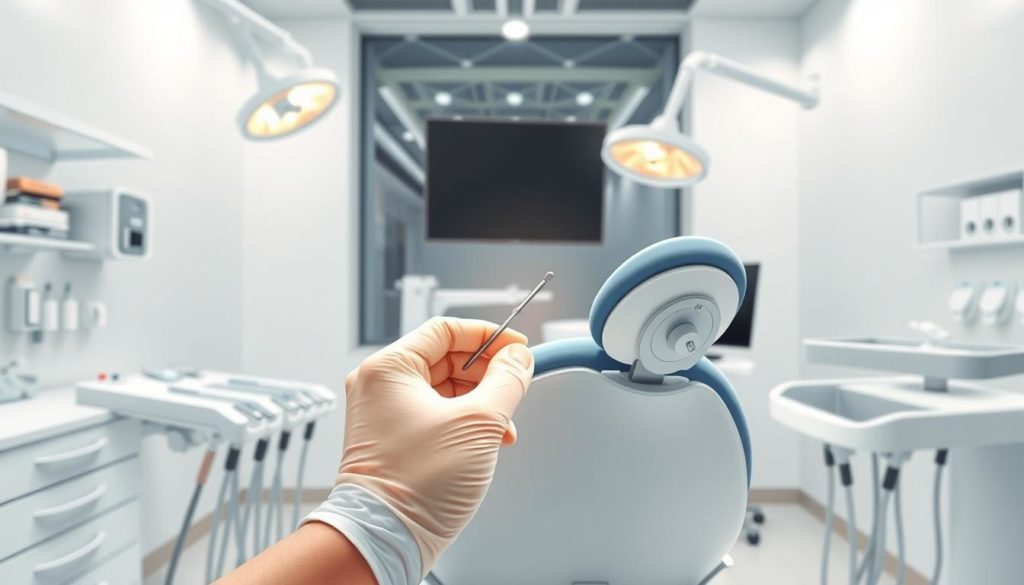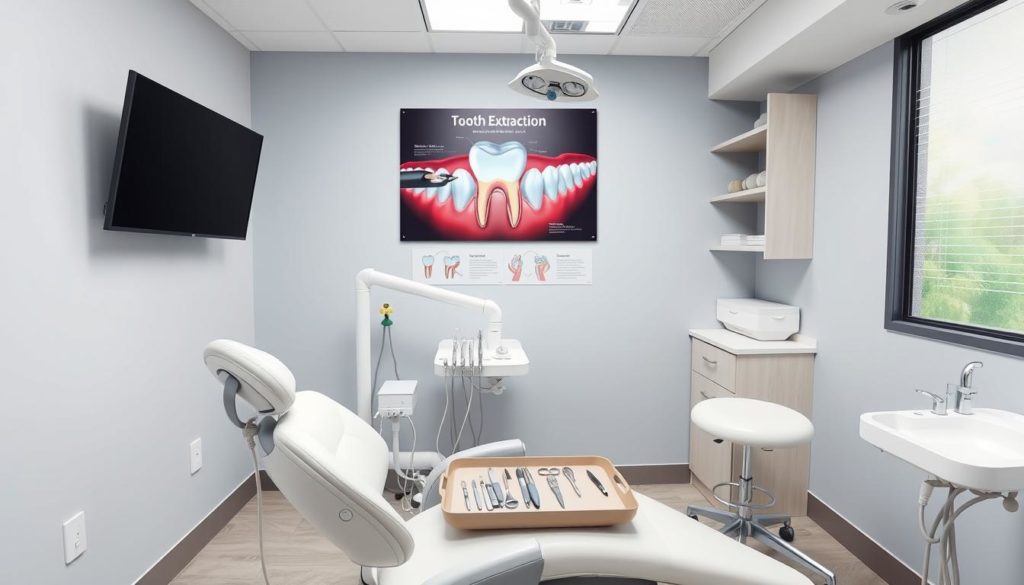Did you know that over 69% of adults aged 35 to 44 have lost at least one permanent tooth? Given its prevalence, understanding the process of Painless Tooth Extraction has never been more important. Whether you’re dealing with significant tooth damage, infection, or crowding, a professional Dental Extraction can offer relief and restore your oral health.
Gone are the days when Tooth Removal was synonymous with excruciating pain. Thanks to advances in dental practices and anesthesia, today’s procedures are much more comfortable. This guide will show you how to have a smooth and stress-free tooth extraction experience.
Understanding Tooth Extraction: What You Need to Know
Tooth extraction is often done to keep your mouth healthy. It’s a usual dental surgery for various reasons. We will look at why teeth are removed and the types of tooth extraction.

Types of Tooth Extraction
There are two main kinds: simple and surgical extractions. Simple extractions are done on teeth that you can see. They’re quite straightforward, needing only a local numbing agent.
Surgical extractions are tougher, removing teeth that are hard to reach, like impacted teeth. These need stronger anesthesia and a specialist.
Common Reasons for Tooth Extraction
Several issues may lead to pulling a tooth. Bad tooth decay that fillings or root canals can’t fix is a common cause. Infection spreading into the tooth and nearby areas may require extraction too.
Gum disease weakening the tooth’s foundation can also force a removal. Removing teeth can also stop overcrowding, helping the rest of your teeth stay straight.
Orthodontic treatments sometimes need teeth removal to make space. Wisdom teeth, prone to problems, are often removed to avoid future issues.
| Type of Extraction | Procedure | Anesthesia |
|---|---|---|
| Simple Extraction | Removal of visible teeth | Local Anesthesia |
| Surgical Extraction | Removal of impacted or non-visible teeth | General Anesthesia |
Preparing for Your Tooth Extraction Procedure
Getting ready for your tooth extraction can make the process easier and more comfortable. Being informed and prepared is key for a smooth experience. Here’s everything you need to know to get ready:
Consultation and X-Rays
Before your extraction, you’ll have a meeting with your dentist. This is to check your tooth and general dental health. You’ll also get dental X-Rays. They look at the bone and tooth roots to plan your extraction well.

Pre-Procedure Instructions
Your dentist will give you specific directions to follow before your extraction. These directions include:
- Medication Adjustments: Your dentist may change or halt certain medicines to lower risks during the process.
- Fasting: You might need to fast for a while before the extraction if using general anesthesia.
- Post-Procedure Care: Make sure you have a ride and help after the extraction, especially if you’re being put to sleep.
Following these instructions carefully will help make your tooth extraction safe and successful.
What to Expect During the Tooth Extraction
Understanding the tooth extraction process can make things less scary. This guide will walk you through the necessary steps, including anesthesia’s role and how the extraction works.
The Role of Anesthesia
Anesthesia makes tooth extractions comfortable and pain-free. Based on the tooth extraction needs, various anesthesia types might be used. Local anesthesia numbs the area, while sedation or general anesthesia is for more intense procedures.
The Extraction Process Explained
The condition of your tooth dictates the extraction method. A simple extraction uses tools to loosen and remove the tooth. If the tooth is impacted or broken, a surgical removal is needed. This involves cutting into the gum and removing any bone blocking the tooth.
| Type of Extraction | Description | Anesthesia Used |
|---|---|---|
| Simple Extraction | Removal of a visibly accessible tooth | Local Anesthesia |
| Surgical Extraction | Complex cases involving incisions in the gum | Local, Sedation, or General Anesthesia |
Healing properly after an extraction means following your dentist’s advice closely. Some discomfort is normal but can be eased with painkillers and proper care.
Recovery Tips for a Smooth Healing Process
Taking the right steps after tooth extraction is key. It helps avoid issues and speeds up healing. Paying close attention to aftercare is crucial.
Managing Pain and Discomfort
It’s important to manage pain after getting a tooth pulled. You should use painkillers as your dentist suggests. Cold packs can also reduce swelling and pain.
Make sure to rest a lot and steer clear of things that could make the pain worse. For good tooth extraction recovery, listen to your dentist and take it easy for a while.
Dos and Don’ts After Tooth Extraction
After pulling a tooth, there are important things to do and avoid:
- Dos: Eat soft foods, drink lots of water, and gently wash your mouth with saltwater.
- Don’ts: Skip hard activities, smoking, using a straw, and spitting hard.
Following these tips is essential. They help keep the blood clot in place at the extraction spot. This ensures a smoother recovery.
Impacted Tooth Extraction: A Special Case
Removing an impacted tooth is more complex than normal tooth removal. This process is needed for teeth that haven’t fully emerged. They might not have enough space or grow at the wrong angle.
These extractions often require surgery. The dentist might need to cut into the gums or even remove some bone. Because of the complexity, oral surgery experts usually perform these operations.
The table below outlines the key differences between standard tooth extraction and impacted tooth extraction:
| Type of Extraction | Procedure Complexity | Common Interventions |
|---|---|---|
| Standard Tooth Extraction | Low to Moderate | Simple tooth removal |
| Impacted Tooth Extraction | High | Surgical incisions, bone removal |
For an impacted tooth extraction, it’s best to see an oral surgery specialist. They have the right skills and experience. They help make recovery smoother and reduce risks.
Wisdom Teeth Removal: What Makes It Different
Removing wisdom teeth is a special kind of dental surgery. It’s because of where wisdom teeth are and the problems they can cause. Wisdom Tooth Extraction Procedure helps prevent or fix issues like crowding and infections.
Why Wisdom Teeth Are Commonly Extracted
People often need to get their wisdom teeth taken out to:
- Prevent teeth from getting too crowded
- Stop infections from teeth that haven’t come in all the way
- Get rid of cysts and other growths
- Protect the teeth nearby
Wisdom teeth are at the very back of your mouth and come in last. This often leads to problems.
Procedure and Recovery for Wisdom Teeth Removal
The Wisdom Tooth Extraction Procedure changes based on how the teeth have grown. Here’s what happens:
- Consultation and Assessment: First, there are X-rays and checks to plan the removal.
- Anesthesia: You get local or general anesthesia to not feel pain during the process.
- Extraction: Taking out the tooth might be simple or need surgery if it’s stuck.
- Recovery: After, you manage pain and swelling, eat soft foods, and see the dentist for check-ups.
Following your dentist’s instructions post-surgery speeds up healing. It helps reduce pain and prevents infection.
Choosing the Right Oral Surgeon for Your Tooth Extraction
Finding the right oral surgeon is important for a good tooth extraction. Look for someone with the right skills and who talks clearly. This makes your treatment go smoothly.
Qualifications to Look For
When picking a dentist, important qualities matter:
- Board Certification: Make sure the surgeon has board certification. This shows they meet high standards.
- Experience: Choose someone with a lot of practice, especially in cases like yours.
- Patient Reviews: Reviews can tell you about the surgeon’s work and how happy people were.
Questions to Ask Your Oral Surgeon
Being prepared is vital when seeing an oral surgeon. Think about these questions:
- Familiarity: Ask how well they know the procedure you need.
- Expected Outcomes: Ask what results you should expect and the risks.
- Treatment Plan: Talk about the full plan, including care after the procedure and what if there are problems.
Review this table when picking your dentist:
| Factor | Importance | Details |
|---|---|---|
| Board Certification | High | Ensures high professional standards |
| Experience | High | More experience usually means better outcomes |
| Patient Reviews | Medium | Helps gauge patient satisfaction and reputation |
| Communication | High | Clear and effective communication is vital |
Cost of Tooth Extraction: What to Expect
The cost of removing a tooth can change a lot, leaving many unsure about expenses. Understanding what affects the cost is key to being well-prepared.
Factors That Affect the Cost
Certain factors play a role in figuring out how much you’ll pay for a tooth extraction. These factors include:
- Type of Extraction: A basic extraction costs less than taking out teeth stuck in the gum.
- Anesthesia Requirements: Using local numbing is cheaper than being fully asleep or sedated.
- Geographic Location: Prices change depending on where you live, often costing more in cities.
- Surgeon’s Experience: Dentists with a lot of experience might have higher prices.
Insurance Coverage for Tooth Extractions
Many dental insurances cover some of the cost for tooth removal if it’s needed for health reasons. But, the amount of coverage can be different for each policy.
Before you get any surprises on the bill, check with your dentist and insurance. Ask them:
- How much of the removal cost does your plan cover?
- Are there any copays or limits on what they’ll pay?
- Is the cost of numbing and follow-up visits included?
Some dentist offices offer payment plans to make budgeting easier. Always ask about all possible costs beforehand.
Common Misconceptions About Tooth Extraction
Despite big steps forward in dental care, myths about tooth extraction still make people anxious. Many think tooth extractions are always very painful and lead to problems. This is not the case at all. Today’s dental work aims to make extractions barely hurt. They use the latest anesthesia and precise methods, making the procedure much more comfortable.
Addressing Common Myths
Some believe tooth extraction can cause long-term health problems. But in truth, with a skilled oral surgeon, it’s safe and can improve oral health. Another myth is that recovering takes a long time and hurts a lot. Nowadays, with better techniques and recovery plans, healing is faster and easier. People are often surprised by how easy recovery can be if they follow aftercare instructions from their dentist.
The Reality of Modern Tooth Extraction Techniques
Today’s tooth extraction methods are less scary than before. Better imaging like digital X-rays helps with planning and doing extractions. Dental offices also offer better sedation choices, including local anesthesia and sedation dentistry, for a worry-free experience. Knowing the truth about these methods helps patients feel more confident. It shows the advantages of modern dentistry.
FAQ
What is a painless tooth extraction?
Painless tooth extraction means taking out a tooth with little discomfort. It uses anesthesia and modern methods for a smooth experience.
Why might I need a tooth extraction?
Tooth extraction may be needed for severe decay, infection, gum disease, or overcrowding. These can impact oral health and cause more issues.
What types of tooth extractions are there?
Extractions come as simple or surgical. Simple ones are for visible teeth under local anesthesia. Surgical ones are for hard-to-reach teeth and may need general anesthesia.
What should I expect during the consultation for my tooth extraction?
Your dentist will check your tooth and oral health during the consultation. They might do X-rays. You’ll get instructions for preparation too.
How is anesthesia used during a tooth extraction?
Anesthesia keeps you comfortable and pain-free during extraction. The type used depends on the procedure’s complexity.
What does the extraction process involve?
The extraction process is different for simple and surgical procedures. Simple extractions require tools to loosen and remove the tooth. Surgical extractions might need cuts in the gum and bone removal.
How can I manage pain and discomfort after a tooth extraction?
Pain and discomfort post-extraction can be eased with painkillers, cold compresses, and aftercare instructions.
What should I do and avoid after a tooth extraction?
Post-extraction, avoid hard exercise, smoking, and using straws. Eat soft foods and rinse with saltwater gently. Don’t spit forcefully.
What makes impacted tooth extraction different?
Impacted tooth extractions tackle teeth that haven’t fully come in due to space or growth issues. They usually need an oral surgeon.
Why are wisdom teeth commonly extracted?
Wisdom teeth can cause crowding, infection, cysts, and harm to nearby teeth. They’re often impacted or grow wrongly.
What should I consider when choosing an oral surgeon for my extraction?
Look for an oral surgeon with the right qualifications, case experience, and good reviews. Discuss their experience, risks, and care plan.
How much does a tooth extraction cost?
Tooth extraction costs differ by type, anesthesia, location, and surgeon’s experience. Insurance might cover some costs. Always ask about all potential expenses.
What are some common misconceptions about tooth extraction?
Some think extractions are always painful and risky. But today’s methods and care make them safer and less painful than assumed.


